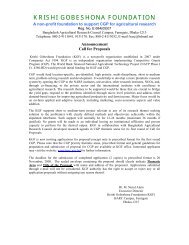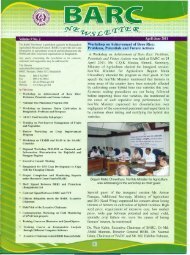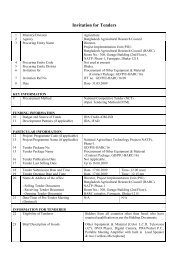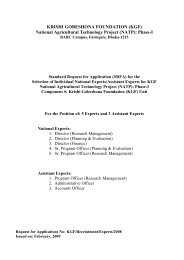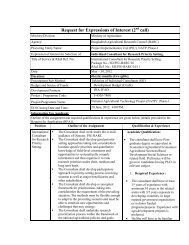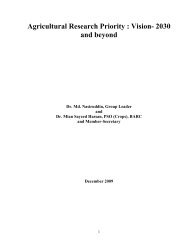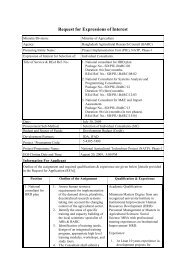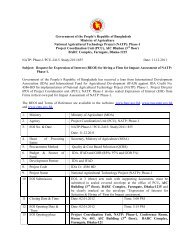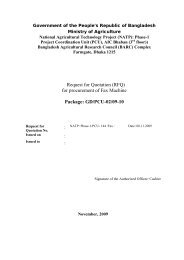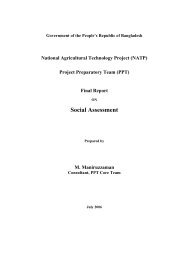ICT in Agriculture and Disaster Management - Bangladesh ...
ICT in Agriculture and Disaster Management - Bangladesh ...
ICT in Agriculture and Disaster Management - Bangladesh ...
You also want an ePaper? Increase the reach of your titles
YUMPU automatically turns print PDFs into web optimized ePapers that Google loves.
e-Information Center based ‘Batighar’ <strong>and</strong> ‘e-Krishok’ campaign was launched <strong>in</strong><br />
November 2008 jo<strong>in</strong>tly by of <strong>Bangladesh</strong> Institute <strong>ICT</strong> <strong>in</strong> Development (BIID),<br />
Grameen Phone (GP) <strong>and</strong> Katalyst <strong>Bangladesh</strong>. e-Krishok was with the aim to deliver<br />
the benefits of <strong>ICT</strong> to the farmers so that they can take advantage of <strong>ICT</strong> <strong>in</strong> each village<br />
of <strong>Bangladesh</strong> <strong>in</strong> ga<strong>in</strong><strong>in</strong>g access to new production techniques, technology <strong>and</strong> other<br />
essential <strong>in</strong>puts like seed, pesticides <strong>and</strong> fertilizer. BIID <strong>and</strong> Zanala <strong>Bangladesh</strong> deliver<br />
benefits of <strong>ICT</strong> to the Farmers. In the last few months, e-Krishok has grown to become<br />
one the very best campaign to br<strong>in</strong>g the benefits of <strong>ICT</strong> to rural <strong>Bangladesh</strong> (S<strong>in</strong>gha,<br />
2008).<br />
<strong>Bangladesh</strong> Institute of <strong>ICT</strong> <strong>in</strong> Development (BIID) signed an MOU with Pacific<br />
<strong>Bangladesh</strong> Telecom Limited (PBTL) to establish 500 “Batighar” by 2011, <strong>and</strong> to have a<br />
presence <strong>in</strong> each Union Parishad by 2015. This “Batighar” project will utilize the<br />
power of <strong>ICT</strong> to promote development of rural people, farmers by provid<strong>in</strong>g them<br />
with <strong>in</strong>formation <strong>and</strong> advisory services <strong>and</strong> as well as create an enabl<strong>in</strong>g environment<br />
for local rural enterprises to flourish. The two parties agreed to make Batighar a<br />
lead<strong>in</strong>g <strong>and</strong> susta<strong>in</strong>able telecenter network <strong>in</strong> <strong>Bangladesh</strong>, where farmers will be<br />
tra<strong>in</strong>ed to use Batighar as the preferred po<strong>in</strong>t to receive agricultural related<br />
<strong>in</strong>formation services. Besides they agreed to develop content for agriculture, MSME,<br />
education, health, environment <strong>and</strong> citizen services (S<strong>in</strong>gha, 2008).<br />
Remote Sens<strong>in</strong>g & Geographic Information System<br />
A GIS is a specific <strong>in</strong>formation system applied to geographical data <strong>and</strong> is ma<strong>in</strong>ly<br />
referred to as a system of hardware, software, <strong>and</strong> procedures designed to support the<br />
capture, management, manipulation, analysis, model<strong>in</strong>g <strong>and</strong> display of spatiallyreferenced<br />
data for solv<strong>in</strong>g complex plann<strong>in</strong>g <strong>and</strong> management problems. The GIS is<br />
characterized by a great diversity of applications <strong>and</strong> concepts developed <strong>in</strong> many<br />
areas- agriculture, statistics, computer science, graphics, mathematics, survey<strong>in</strong>g,<br />
cartography, geology, geography, database technology, resource management <strong>and</strong><br />
decision mak<strong>in</strong>g etc.<br />
A key characteristic of geographic systems analysis is that location of an observation is<br />
known. The addition of location <strong>in</strong>formation adds value to the impact assessment of<br />
agricultural research (Nelson, 2003). Wood <strong>and</strong> Chamberl<strong>in</strong> (2003) affirmed that one<br />
attraction of spatial analysis is its capacity to represent simultaneously the spatial<br />
variability of many key factors <strong>in</strong>fluenc<strong>in</strong>g agricultural production decisions <strong>and</strong><br />
performance: climate, terra<strong>in</strong>, soils, water resources, <strong>and</strong> the physical accessibility of<br />
<strong>in</strong>frastructure <strong>and</strong> markets. In the same framework, these factors can be juxtaposed<br />
aga<strong>in</strong>st the spatial distribution of ecosystems, people, crops, livestock, <strong>and</strong> the threat<br />
of pests <strong>and</strong> diseases. In theory, this analytical capacity holds great promise for our<br />
ability to better underst<strong>and</strong> the ranges <strong>and</strong> comb<strong>in</strong>ations of socioeconomic <strong>and</strong><br />
environmental conditions under which agriculture takes place <strong>and</strong>, therefore, to make<br />
more <strong>in</strong>formed assessments of the potential impacts of specific policy, <strong>in</strong>stitutional<br />
<strong>and</strong> technological <strong>in</strong>novations. In practice, there are very few impact assessment<br />
applications, at the meso or macro scale, <strong>in</strong> which GIS has played a significant<br />
analytical role -rather than serv<strong>in</strong>g simply as a data mapp<strong>in</strong>g tool. Geographic<br />
Information System <strong>and</strong> remote sens<strong>in</strong>g are also used for Precision Farm<strong>in</strong>g or<br />
precision agriculture<br />
39






